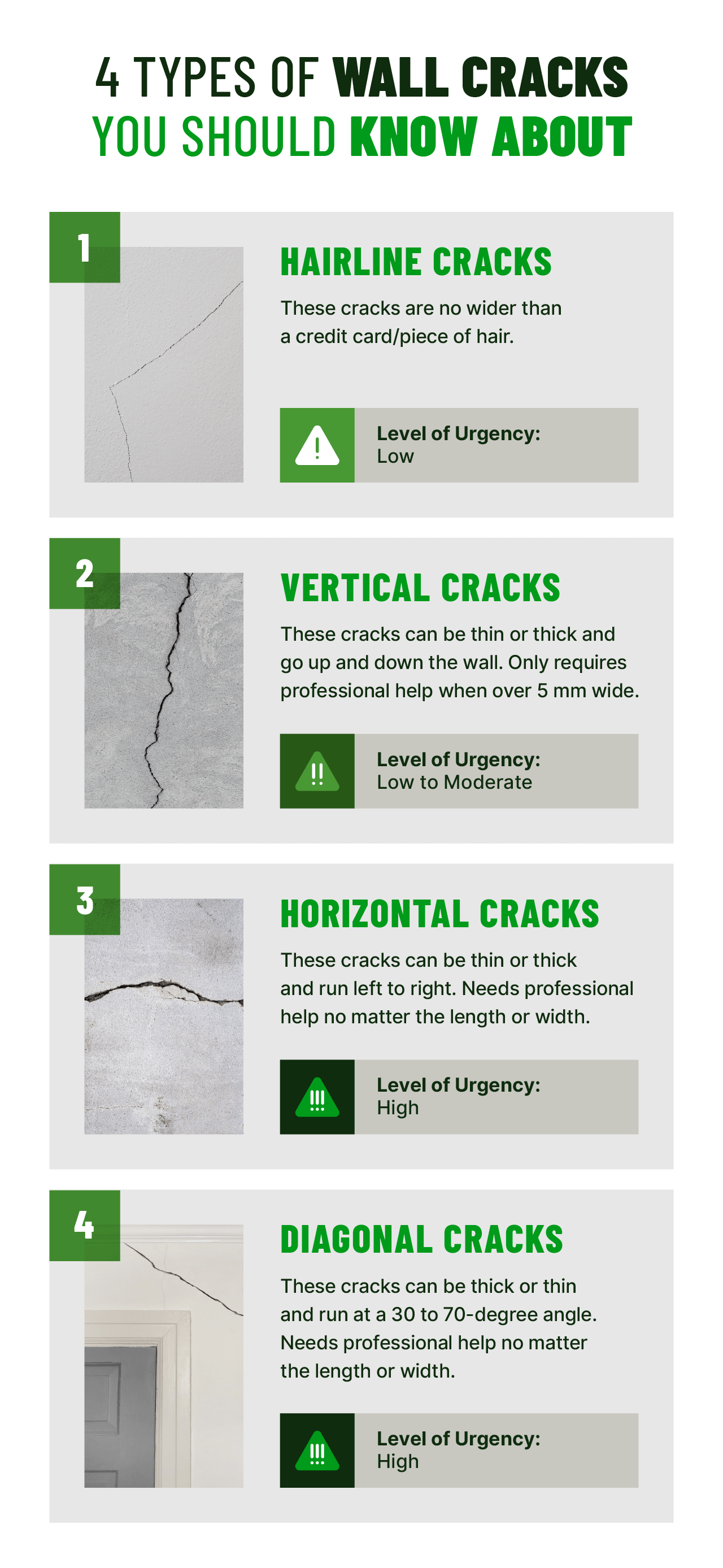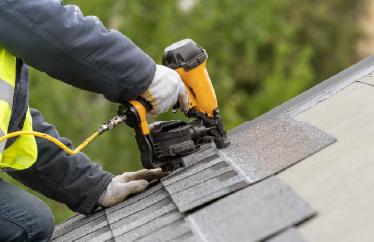The Cracks in the Walls Homeowners Shouldn’t Ignore

Cracks in the walls can reveal a lot about your home’s health. These imperfections are a natural result of everyday use — and sometimes can be a sign of something more serious.
Some cracks can appear within the first year as your house settles and dries out, but timing and severity of certain cracks depend on factors like your home’s construction type, building quality, foundation, and soil conditions.
Small cracks? Not an immediate issue. Big ones? Don't let them become big problems. Catch them early and you may save yourself time, money, and stress.
In this guide, we’ll go over the different types of wall cracks, common root causes, and the best course of action for completing repairs.

1. Hairline cracks
Level of urgency: Low
Thin, spiderweb-like hairline cracks are less than 1 millimeter wide — about the width of a human hair — and are the most common drywall cracks. They appear due to normal house settling or minor fluctuations in temperature and humidity.
Hairline cracks can run in any direction and don't require immediate attention. You’ll still want to monitor the cracks each week to check for a change in length and width and address any moisture issues like improper drainage. If you notice the crack growing wider or longer, consult a professional structural engineer for evaluation to assess the cause and recommend any necessary repairs.
Hairline cracks can be caused by:
- Settling: As a house settles into its foundation, slight shifts can lead to minor cracks in the drywall or plaster.
- Temperature Changes: Seasonal temperature variations cause building materials to expand and contract.
- Humidity Changes: Changes in humidity levels can cause drywall or plaster to contract or expand.
Actions to take:
- Step 1: Monitor the crack weekly for any growth.
- Step 2: Download our free Hippo Home app to get DIY guides for how to inspect your interior walls.
- Step 3: Patch and repaint the hairline crack using a joint compound, which is a paste made of gypsum powder and other binders that can be spread onto the crack and sanded when dry.
2. Vertical cracks
Level of urgency: Low to Moderate
As a result of foundation settlement, vertical cracks travel straight up and down, following the line where the wall meets the floor, and vary in size. These cracks generally pose minimal concern if there are no significant length or width increases.
Vertical cracks need to be assessed once they are greater than 5 millimeters wide. If the crack is close enough to the ground and easily accessible, use a ruler to measure its width. For high cracks, mark either side with a pencil 1 inch apart and monitor the distance. If you detect dampness or widening cracks, seek professional help.
Vertical cracks can be caused by:
- Settling: Both newer and older homes can experience settling into their foundation. While newer homes may settle more noticeably due to the initial adjustments of the building materials, older homes might have already undergone significant settling over time, which can also lead to cracks in the walls.
- Temperature Changes: Temperature fluctuations can make building materials expand and contract slightly.
The urgency of addressing a vertical crack depends on its size:
- Low Urgency: Hairline vertical cracks are generally low priority, especially if they haven't changed.
- Moderate Urgency: Cracks wider than 3 millimeters warrant a professional evaluation.
Actions to take:
- Step 1: For hairline vertical cracks, monitor them weekly for any changes in size or length.
- Step 2: If the cracks widen or you have concerns, consult a foundation specialist for a professional assessment.
3. Horizontal cracks
Level of urgency: High
Horizontal cracks running along the wall plane can be a serious sign of foundation issues and potential structural drywall cracks. These cracks are often the result of structural movement as expansive soils build up against the foundation wall. They will progressively widen without proper care, potentially causing complete wall failure.
Consult a professional for any horizontal crack, regardless of width. This urgency is because horizontal cracks signify movement or pressure on the foundation walls. Early detection and intervention are crucial to prevent further damage.
Horizontal cracks can be caused by:
- Foundation Movement: Uneven settling of the foundation puts stress on walls, causing them to crack horizontally. This is due to poor soil conditions, moisture issues, or changes in water drainage around the house. While horizontal cracks may be more commonly associated with newer homes, older homes are not exempt. Factors such as moisture problems or changes in water drainage around the house can also contribute to foundation movement and horizontal cracking.
Actions to take:
- Step 1: Consult a foundation specialist or structural engineer for a professional assessment.
- Step 2: The professional should be able to help diagnose the cause of the crack and recommend the most appropriate course of action, which may involve foundation repair or structural reinforcement.
4. Diagonal cracks
Level of urgency: High
Diagonal cracks run at an angle on the wall from corner to corner, slanted at a 45-degree angle compared to the vertical wall plane. These cracks, regardless of size, need immediate attention from a professional.
Early intervention is key since diagonal cracks are a sign of foundation settlement, often as a result of the earth pushing on the concrete basement wall. Early detection and intervention are crucial to preventing more extensive damage to your foundation and the overall structural integrity of your home.
Diagonal cracks can be caused by:
- Poor Soil Compaction: If the soil supporting your foundation wasn't adequately compacted during construction, it will settle unevenly over time. This uneven settling puts stress on the walls, causing them to crack diagonally.
- Changes in Moisture Content: Fluctuations in soil moisture content lead to uneven settling. For example, during droughts, the soil shrinks, causing the foundation to shift and walls to crack.
- Inadequate Drainage: Poor drainage around the house leads to water pooling near the foundation. This saturated soil puts uneven pressure on the foundation.
Actions to take:
- Step 1: Contact a foundation specialist or structural engineer as soon as possible for a professional assessment.
- Step 2: The professional can diagnose the cause of the crack and recommend the most appropriate course of action, which may involve foundation repair, soil stabilization techniques, or structural reinforcement.
What causes cracks in walls and ceilings?
Cracks are most commonly caused by expansion and contraction of building materials. This occurs due to changes in both moisture content and temperature. These minor shifts can lead to hairline cracks in drywall or plaster, especially in newer homes during the first few years. Use a home maintenance checklist to help you monitor changes in your home and plan repairs like foundation work.
Construction imperfections may also be a contributing factor. For instance, improperly taped drywall joints or shrinkage in concrete foundation walls lead to cracks.
Leaks from roofs, plumbing, or poor ventilation can also lead to moisture buildup in walls, causing cracks. As a homeowner, it’s important to look out for any moisture present to help prevent water damage and further structural damage.
When to worry about cracks in the wall
Not all cracks are created equal. The size and location of wall cracks are key factors. Large cracks wider than 5 millimeters are a cause for concern, especially if they are diagonal, horizontal, or above a door frame. These cracks could indicate foundation movement, stress on structural supports, or settling issues. It’s helpful to get a professional opinion in these cases.
The presence of multiple cracks, especially if they are clustered together in a specific area, also calls for attention. This suggests there could be a widespread problem that requires a professional evaluation to determine the cause and best course of action.
By addressing cracks promptly, you can help prevent them from worsening and safeguard the structural integrity of your home.
While not always a cause for alarm, cracks in your walls or ceilings are fairly common. They might seem visually alarming, but understanding them can help identify the difference between a minor cosmetic imperfection and a more significant structural problem. The free Hippo Home app provides a personalized checklist to monitor those settling cracks and other potential issues.
Download the Hippo Home app today from the Google Play Store or App Store to help you tackle minor maintenance tasks yourself.
Disclaimer:
YourHaus, Inc. (“Hippo Home”) is an affiliate of Hippo Insurance Services. Services (including all repair or maintenance services) provided to customers through affiliated and unaffiliated third-party contractors. Services provided by Hippo Home include speaking to a home care specialist, or providing repairs or maintenance either remotely or on site. Use of Hippo Home is subject to Hippo Home’s terms and conditions and privacy policies. Use of unaffiliated third-party vendors is subject to the terms of service provided by such third party. Hippo Insurance Services is not responsible for your use/non-use of Hippo Home or any service vendor. © YourHaus, Inc. 202
Hippo Insurance Services ("Hippo") is a general agent for affiliated and non-affiliated insurance companies. Hippo is licensed as a property casualty insurance agency in all states in which products are offered. Availability and qualification for coverage, terms, rates, and discounts may vary by jurisdiction. We do not in any way imply that the materials on the site or products are available in jurisdictions in which we are not licensed to do business or that we are soliciting business in any such jurisdiction. Coverage under your insurance policy is subject to the terms and conditions of that policy. Coverage and coverage amounts selected are the decision of the buyer.
This guidance and advice is not error-proof and not applicable to every home. You are responsible for determining the proper course of action for your property and neither Hippo nor Hippo Home is responsible for any damages that occur as a result of any advice or guidance.



